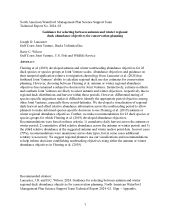
Joseph D. Lancaster
Gulf Coast Joint Venture, Ducks Unlimited Inc.
Barry C. Wilson
Gulf Coast Joint Venture, U.S. Fish and Wildlife Service
ABSTRACT
Fleming et al. (2019) developed autumn and winter nonbreeding abundance objectives for 23 duck species or species groups at Joint Venture scales. Abundance objectives and guidance on their temporal application relative to migration chronology from Lancaster et al. (2024) has furthered Joint Ventures’ ability to calculate regional duck use day estimates for conservation planning. However, choosing between Fleming et al. autumn or winter regional abundance objectives has remained a subjective decision for Joint Ventures. Instinctively, extreme northern and southern Joint Ventures are likely to select autumn and winter objectives, respectively due to regional duck distributions and harvest within those periods. However, differential timing of species-specific migrations makes it difficult to identify the appropriate period objective among other Joint Ventures, especially those at mid-latitudes. We developed a visualization of regional daily harvest and eBird relative abundance information across the nonbreeding period to allow planners to make informed species-specific decisions to use Fleming et al. (2019) autumn or winter regional abundance objectives. Further, we make recommendations for 23 duck species or species groups for which Fleming et al. (2019) developed abundance objectives. Recommendations were based on three criteria; 1) cumulative daily harvest across the autumn or winter period; 2) cumulative eBird relative abundance across the autumn or winter period; and 3) the eBird relative abundance at the suggested autumn and winter anchor point date. In most cases (79%), recommendations were unanimous across data types, but in some cases additional scrutiny is necessary. We suggest regional planners use our visualizations and recommendations to help inform decisions establishing nonbreeding objectives using either the autumn or winter abundance objectives in Fleming et al. (2019).
